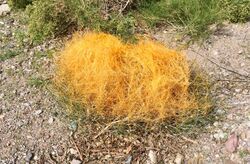Biology:Cuscuta denticulata
| Cuscuta denticulata | |
|---|---|

| |
| Scientific classification | |
| Kingdom: | Plantae |
| Clade: | Tracheophytes |
| Clade: | Angiosperms |
| Clade: | Eudicots |
| Clade: | Asterids |
| Order: | Solanales |
| Family: | Convolvulaceae |
| Genus: | Cuscuta |
| Species: | C. denticulata
|
| Binomial name | |
| Cuscuta denticulata Engelm.
| |
Cuscuta denticulata, commonly known as desert dodder[1] or small-toothed dodder, is a thin, yellow to orange, parasitic annual vine in the morning glory family (Convulvulaceae), native to the deserts of the south-western United States and northern Mexico.[2]
Description
Growth pattern
It is an annual plant that grows as a very thin orange-ish parasitic vine, with clumping twinings around the host stems.[2] It parasitizes the host by sending small, short-lived rootlets (haustoria) into its tissues, from which it absorbs moisture and nutrients.[2]
Leaves and stems
Yellow to orange stems are without hairs, with minute scale-like leaves.[2]
Inflorescence and fruit
It blooms from May to October with tiny spikes of clusters of miniature white, 5-parted bell shaped flowers.[2] Corolla lobes are bent back, with overlapping calyx lobes.[2] Both calyx and corolla have fine teeth on their margins, hence the species name and common name.[2] Fruits are conical capsules.[2]
Habitat and range
It grows up to 4,000 feet (1,200 m) in the Mojave Desert and Sonoran Desert into Baja California.[2] It parasitizes plants of the creosote bush scrub and Joshua tree woodland communities, such as creosote bush (Larrea tridentata) and cheesebush (Ambrosia salsola).[2]
References
- ↑ "Cuscuta denticulata". Natural Resources Conservation Service PLANTS Database. USDA. https://plants.usda.gov/core/profile?symbol=CUDE2. Retrieved 24 June 2015.
- ↑ 2.0 2.1 2.2 2.3 2.4 2.5 2.6 2.7 2.8 2.9 Mojave Desert Wildflowers, Pam MacKay, 2012, 2nd ed, p. 146
Wikidata ☰ Q1145995 entry
 |

